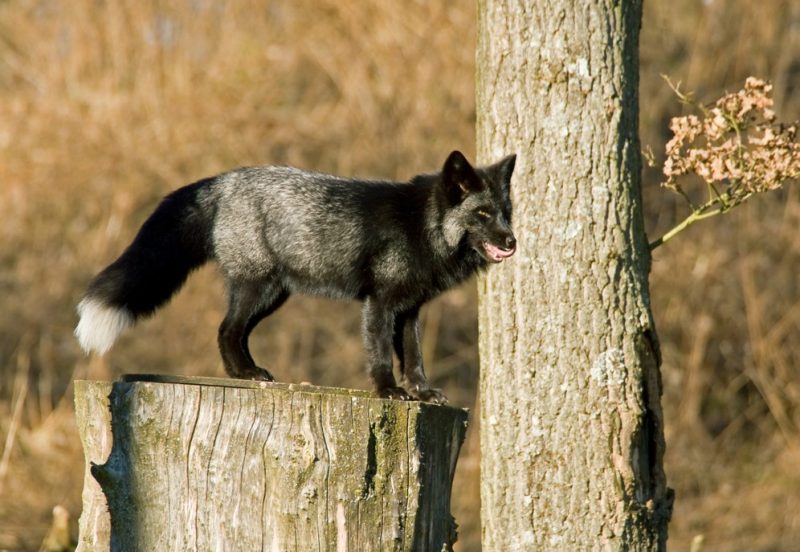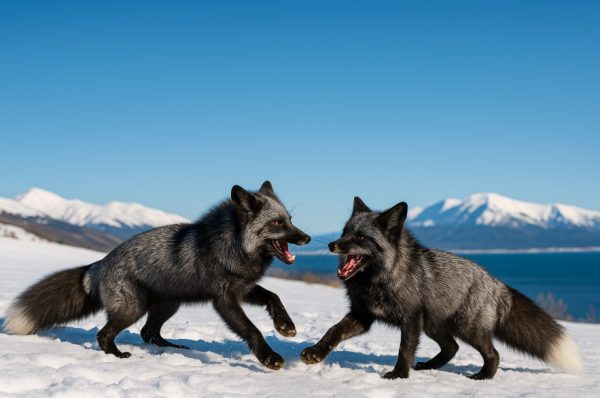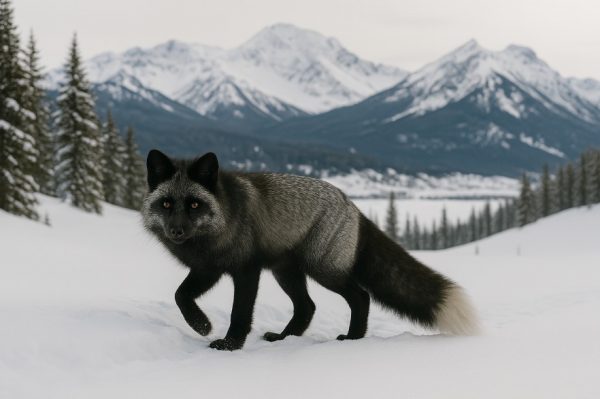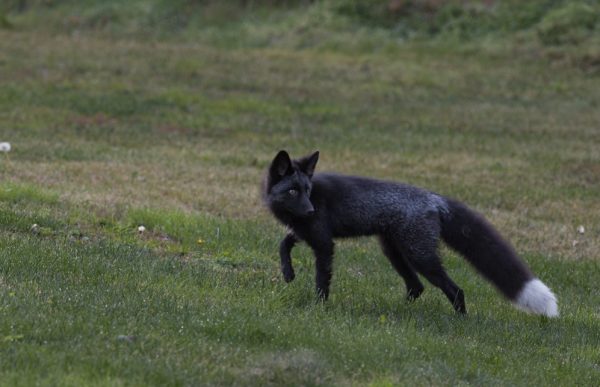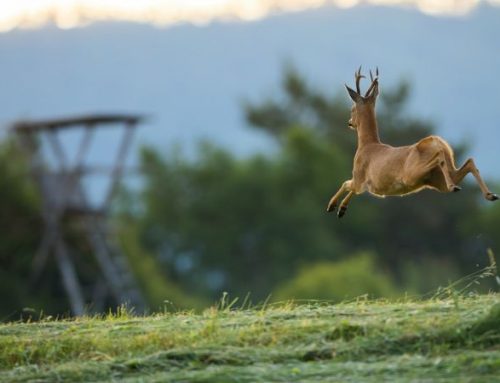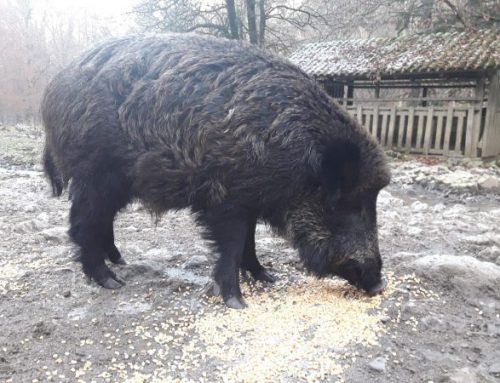In the vast and breathtaking spectrum of wild beauty that graces our planet, few creatures possess the enigmatic allure and captivating mystique of the silver and black fox.
These strikingly beautiful color morphs, born from the genetic tapestry of the ubiquitous red fox (Vulpes vulpes), move through the undergrowth like living fragments of folklore—ethereal specters of the woodland, their existence a testament to the intricate dance of heredity and the enduring power of natural selection.
Their pelts, a luxurious tapestry woven in shades ranging from the deepest, velvety charcoal to the most luminous, almost liquid metallic silver, are a natural marvel, evoking a sense of wonder and admiration in all who encounter them. Hunters, drawn by the challenge and the exceptional quality of their fur, naturalists, fascinated by their ecological role and genetic variance, and photographers, captivated by their photogenic splendor against the backdrop of the natural world, all hold these creatures in a unique regard. The sight of a silver fox slipping through a snow-dusted forest or a black fox melting into the shadows of twilight is an experience that etches itself into memory, a fleeting glimpse into the wild heart of nature.
But a question often arises among hunters, especially those with a deep respect for rarity and tradition: Are silver and black foxes huntable? And perhaps more importantly: Should they be?
The Genetic Enigma
Silver and black foxes are not separate species but rare color morphs of the red fox, resulting from a genetic mutation in the expression of melanin. These morphs are recessive and therefore much rarer in the wild, making up only a small percentage of red fox populations. Historically, silver foxes were among the most prized animals in the fur trade—so rare in the wild that they once fetched astronomical prices in 19th-century Europe and Russia.
Tragically, the allure of their fur also led to widespread exploitation. For centuries, silver and black foxes were hunted ruthlessly, not for the hunt itself but for commerce. They were trapped, raised, and farmed in large numbers, reducing a living symbol of wilderness to a luxury commodity. The pursuit of the perfect pelt often ignored any notion of respect or fair chase, replacing admiration with greed.
It took time, education, and a cultural shift for hunting traditions to refocus on ethics and conservation. Today, we have a greater understanding of the importance of rarity, and a deeper appreciation for the responsibility that comes with the hunt.
From a biological perspective, these foxes are nearly identical to their red counterparts. They share the same body shape, size (weighing between 5 to 9 kg), and facial structure. Their behavior is also similar: highly intelligent, solitary foragers, and masterful survivors. Foxes are crepuscular animals, meaning they are most active during twilight hours—at dawn and dusk—making them elusive and difficult to observe, let alone hunt.
Mysterious Behavior and Survival Skills
The silver and black foxes, like all red fox morphs, are highly adaptive animals. They inhabit a wide range of environments, from dense forests and alpine meadows to urban fringes and remote tundras. Their diet is omnivorous and opportunistic: small mammals, birds, eggs, insects, fruits, and even carrion when necessary. Their acute hearing allows them to detect rodents under the snow, and their pounce is as graceful as it is deadly.
They are known for their cautious nature and elusive habits. A black fox in the wild may be seen only once in a hunter’s lifetime. Their movements are silent, often weaving through the undergrowth with the elegance of a shadow. During winter, their dark coats offer a stark contrast against snow-covered landscapes, making them both beautiful and vulnerable.
Foxes are also territorial creatures, marking their ranges with scent to ward off rivals. Despite their solitary lifestyle, they form monogamous pairs during the breeding season, and both parents participate in raising the kits. This bond and parental care make their social structure surprisingly rich and emotional.
Huntable by Law, Respected by Tradition
In most countries where fox hunting is permitted—across Europe, North America, and parts of Asia—the legal framework does not differentiate between color morphs. A red fox is a red fox, regardless of whether its coat blazes orange or glows silver. From a regulatory standpoint, silver and black foxes are huntable game, just like their more common kin.
Yet within the community of responsible hunters—particularly those who view hunting as a craft tied to conservation, ethics, and heritage—there is an unspoken reverence for these animals. Because they are so rare in nature, many choose not to take the shot when a black or silver fox appears. To see one is already a reward. To let it live is, for some, an act of homage.
The Ethical Dimension
Montefeltro has always believed that true hunting is guided not just by rules, but by a deep, internal code—one that balances respect for wildlife with the timeless pursuit of the hunt. While it is legal to hunt silver or black foxes where red fox hunting is allowed, we encourage every hunter to weigh the moment with care. Ethical hunting is not about trophies. It is about connection.
Beyond legality, hunters must also consider the genetic and ecological role these animals play. Because these color morphs are typically less common, even limited hunting pressure targeting them specifically could reduce their frequency in the population. Their presence contributes to biodiversity and the aesthetic wealth of the species—removing too many could dull the natural palette of the wild.
For some, the extraordinary rarity and ethereal beauty of the silver and black fox elevate it beyond a hunting target. These animals embody mystery and resilience. Watching one pass through a glade in early morning mist can be more powerful than any shot ever taken.
If you are fortunate enough to encounter a silver or black fox in the wild, ask yourself: What story will I tell? One of conquest, or of awe?
A Final Thought
At Montefeltro, we support the idea that some of nature’s rarest gifts are meant to be remembered, not harvested. In a world where wild beauty is increasingly rare, the choice to preserve can be just as noble as the skill to take. Let your hunting journey be one of balance, reverence, and wonder.
Because sometimes, the most powerful moment in the field is the one where you simply lower the rifle and watch the shadows run free.
Montefeltro. Where tradition meets respect.
FAQ – Hunting the Black or Silver Fox with Montefeltro
What exactly is a black or silver fox?
The black fox is a melanistic variant of the red fox (Vulpes vulpes). It’s not a separate species, but a rare color phase caused by a genetic mutation that increases melanin in the fur. When the hair is black at the base with silver or white tips, it’s referred to as a silver fox — another striking variation within the same spectrum.
Where do black foxes live in the wild?
Black foxes are rare but can be found throughout the Northern Hemisphere. They are more common in Canada, Alaska, the Baltic states, Russia, and certain parts of Northern and Central Europe. They are extremely rare in Southern Europe and Mediterranean regions.
What are their habits and behavior?
Just like the red fox, black foxes are mostly nocturnal or crepuscular, highly adaptable, and solitary. They inhabit forests, farmlands, and even suburban areas. Their diet includes small mammals, birds, insects, fruits, and occasionally carrion. Their dark coat offers perfect camouflage at night, making them even harder to spot.
How rare is it to see a black or silver fox in nature?
Very rare. It’s estimated that only about 1% of all red foxes display melanistic traits. In parts of Canada, this number may reach 10%, but in Europe, these foxes are an extraordinary sight. Spotting one in the wild is considered a stroke of incredible luck by both hunters and wildlife enthusiasts.
Is hunting a black fox legal?
Yes, in all jurisdictions where red fox hunting is legal, the black or silver morphs can also be legally harvested. However, many outfitters — including Montefeltro — recommend a moment of ethical reflection before deciding to pull the trigger. Letting such a rare animal go can be the noblest act of all.
Does Montefeltro organize hunts specifically for black foxes?
No. Montefeltro does not offer hunts focused solely on black or silver foxes. However, during red fox hunting trips in select regions of Northern Europe, there’s a small chance that a melanistic fox may appear.
What does it feel like to encounter a black fox in the wild?
Hunters who’ve had this privilege often describe it as a magical and emotional moment — a silent, elegant creature emerging from the forest like a shadow. Some are so moved that they choose not to shoot, honoring the moment as something more meaningful than a trophy.
What is Montefeltro’s ethical stance on hunting black foxes?
Montefeltro believes that elegance in hunting lies not only in precision, but also in discernment and respect. Our guides encourage hunters to thoughtfully consider the rarity, symbolic value, and conservation relevance of a black fox before making any decision. Sometimes, the finest trophy is the memory.
Are black foxes more aggressive or elusive than red ones?
There’s no scientific evidence of increased aggression. However, due to their rarity, black foxes tend to be even more elusive, shy, and alert than their red counterparts — making them an even greater challenge for the hunter.
Do black foxes have symbolic meaning in folklore?
Yes. In Celtic and Scandinavian traditions, black foxes are often seen as totemic animals, representing wisdom, awareness, and guardianship. In East Asian folklore, they are sometimes associated with mysticism and transformation, appearing as magical beings in legends.
Is black fox fur still used or traded?
Historically, black and silver fox pelts were highly prized in the fur trade. Today, out of ethical respect and conservation values, Montefeltro does not promote black fox hunting for commercial purposes, and only supports sustainable and selective hunting in regulated areas.
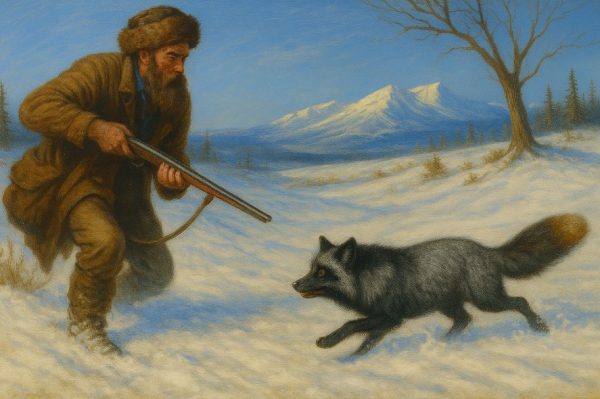
A rare old american painting of a fur hunter chasing a black fox

